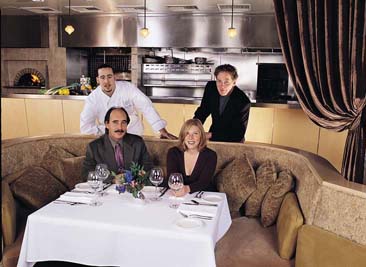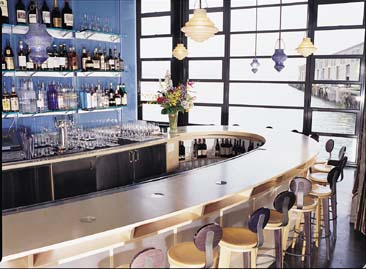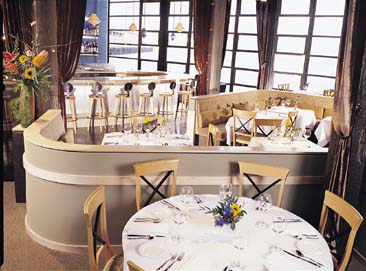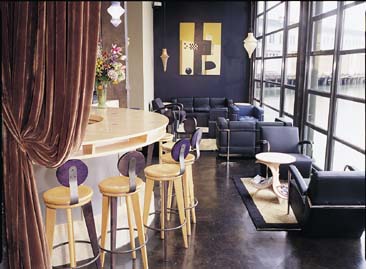Bay AreaWaterfront
Design
Waterfront Chic
|
Steven Smith: Bicontinental Man
Steven Smith, as Managing Partner of Lapis, is a man of many flavors.
He’s also a man of many locales, currently maintaining homes in Bali
and Marin.
Native San Franciscan Smith boasts an impressive restaurant pedigree,
starting with the original Vanessi’s at Kearny and Broadway. But
culinary adventurism took hold and next up was one of the first high-end
Mexican eateries in the City, Pancho Villa in Pacific Heights.
Pancho Villa was successful enough to make possible a zig to Ibiza,
Spain (where Smith managed a jet-setter nightclub called Glory) and then
a zag back to San Francisco, where he opened Danseur in 1983.
That’s when Smith and his Balinese wife opted for a bicontinental
lifestyle, shuttling between homes in Indonesia and California. Mellowed
out, a contented family man and with nothing left to prove, the furthest
thing from Smith’s mind was a return to the backbreaking schedule of
running a top-flight restaurant.
But seduced back he was, by the business plan and personal charm of
Seifi and Sheila Zaki, co-owners of Lapis. The inexpressibly beautiful
setting of Lapis on San Francisco’s Embarcadero was just too much to
resist.
When in Marin he commutes to Lapis by the Golden Gate Ferry, but
Steve Smith wants to know: how about ferry service to Bali ? |
 |
| The
Lapis culinary team, clockwise from rear; Executive Chef Thomas Ricci,
Manager Matthew Fuhrmann, Wine Director Karla Kilgore and Managing
Director Steven Smith |
By Bobby Winston
The City of San Francisco, pioneer of tie-dye, the gay ghetto
and environmentalism now brings you waterfront chic.
Once again, the City is at the cutting edge of a radical departure in how
people live, work and play. The waterfront is "in", just starting to
take off big-time, and there’s no better place to see this phenomena in action
than at the beautiful new Lapis Restaurant at Pier 33.
Until quite recently, political leaders all around the Bay had little use for
the waterfront and even viewed it as dangerous, most likely because unionism
festered there. As a result the waterfront was often literally a dump (look for
large mounds at waterside all around the Bay – they’re covering open-air
landfills closed not so long ago). In the case of San Francisco, planners
vandalized the waterfront by installing the Embarcadero Freeway, a supremely
ugly concrete slab that slashed across the City’s underbelly – and deep into
its aesthetic soul — effectively splitting the community from the Bay.
The 1989 Loma Prieta Earthquake was certainly a terrible disaster but we
should be thankful for one thing: it brought down the Embarcadero Freeway. San
Francisco, reconnected with the Bay, is experiencing an exciting revival of its
waterfront that is a harbinger of the "post freeway" era.
 |
| The
splendid Lapis bar with peerless views of, well, the Pier (33, that is). |
California is about to hit rock bottom with its addiction to cars and
freeways. You could pave over every square inch of California — and pass out
space suits to deal with the resulting air pollution — and you’d still
have gridlock.
People need a different way to live and work. And what’s happening on the
San Francisco waterfront is a preview of how that’s going to be.
City planners, architects and world class entrepreneurs are laying plans for
a return to the
| The
Design Guy
 Bay
Crossings is proud to debut this first in a continuing series of Design
Nazi commentaries by San Francisco interior designer Scott Johnson Bay
Crossings is proud to debut this first in a continuing series of Design
Nazi commentaries by San Francisco interior designer Scott Johnson
I was meeting a friend who was traveling from the
East Bay on the ferry. We decided to grab a drink at a waterfront
restaurant. He suggested a place recently opened…
I walked up to Pier 33 and found Lapis Restaurant. I
pushed through the doors and into an incredible space with soaring
ceilings and a wall of glass. Immediately I felt the warmth of the
space. I took a place at the bar…what a great bar! The undulating
lines of the bar front afforded a view of the bay from every
perspective. I ordered my drink and perched myself where I could take in
the whole space.
My eyes were first drawn up the massive beams
supporting the roof. Thick, century-old beams left in their natural
state and dark from years of warehouse service. The black ceiling,
dotted with small, halogen lighting left me with the sense of looking at
the stars in space. Hanging from the support beams was chocolate brown
velvet, draped and falling some 10 feet to the floor, strategically
separating the dining room from the bar.
The dining room, with juxtaposed banquettes in cut
and patterned gold velvet, afforded a view from every seat. I was seated
at my table and sunk into the warm seat pulling a casually thrown pillow
next to me. I felt as thought I were sinking into a deep comfy sofa. The
blond wood chairs with small animal print faced me and would soon be
filled by my friend.
I continued to absorb the room. The open kitchen
nicely separated from the dining room allowed for the wonderful aroma of
food being prepared to gently touch the nostrils without overpowering
the senses. The music, not too loud or mundane, was a wonderful mix of
1940’s jazz and vocals. My mind drifted to the time of dressing for
dinner and making an evening of dining and dancing.
My friend arrived and we had a wonderful meal. The
restaurant was full and the conversations lively, but not noticed, as
the carpet, drapes and fabrics helped to absorb all peripheral noise and
made for enjoyment of table conversation.
For our after dinner drinks, we retired to the lounge
situated along the back of the dining room and right on the water. Black
leather club chairs and sofas gave the feel of a cocktail lounge of the
1950’s. The wall of glass gave us the impression of a giant movie
screen showing the life on the bay…the ferries moving their cargo back
and forth across the bay with the Berkeley Hills in the distance, dotted
with lights like small campfires of a century and a half ago.
Having sated our appetites, we pushed through the
doors into the cool evening air and walked my friend back to the ferry.
Floral Designs by Amy Kee, Levi Plaza
Murano glass lighting
Bruce Prescott, designer, Adel Santos Associates
415-908-3767 |
past, to a time when it was possible to commute via trains and
ferries from pretty much anyplace in the Bay Area to anyplace else. But there is
nothing nostalgic or anachronistic about these plans; they involve cutting edge
economic and telecommunications concepts that serve the crème de la crème of
the Internet warrior class.
At the heart of these plans: compact communities with exciting and worthwhile
destinations instead of soulless, car-dependent suburban sprawl. What better
place for these communities of the not-so-distant future than the waterfront?
 |
| The
finest interior design Internet money can buy, against the backdrop of
old Mother San Francisco Bay. Gold Rush, Internet Mania: to her, it’s
all the same. |
And not just because that’s where you find the best views, but also because
the waterfront is convenient to all modes of transit. Importantly, ferries prove
that public transportation is not just for within big cities; significant
numbers of folks joyfully commute from relatively small communities such as
Alameda, Vallejo and Sausalito to San Francisco every day.
And when they get to San Francisco, what do they find? Well, right now they
find a drab, barely utilitarian ferry terminal, but that’s about to change
dramatically for the better with the opening of the glamorous San Francisco
Ferry Terminal, just weeks away.
Lapis exemplifies the "new waterfront". Located on Pier 33, not far
from Fisherman’s Wharf in distance but worlds away in style, Lapis follows in
the footsteps of the elegant "new waterfront" pioneer Waterfront
restaurant and represents a case study of what we can expect more of – lots
more of – on waterfronts all around the Bay, not just in San Francisco.
The dream child of high-tech mandarins Sheila and Seifi Zaki (she’s Director
of Finance at Cisco Systems, he’s a high-tech success story in his own right),
Lapis reeks style, elegance and
good taste. Taking over a "problemed"
spaced that has seen several restaurants quickly come and go, the Zaki’s, with
the able assistance of long-time San Francisco restaurant pro Steven Smith (see
inset), have shown that they’re as savvy at picking important lifestyle trends
as they are at picking killer jobs. Doesn’t it just make you sick?
 |
| One
of the best places for a rendezvous in San Francisco: Lapis’ secluded
bar seating area. Handsome leather chairs are arranged smack-dab against
floor-to-ceiling windows overlooking the Bay. |
We decided to write about Lapis because of what it represents in terms of the
emerging new waterfront – hip new place, exciting design, glamorous ownership.
But in the course of preparing this article we’ve had a chance to taste the
food (bless their hearts) and we’re here to tell you: it’s great.
However sluttish it may be journalistically, this writer feels compelled to
evangelize the Nicoise salad. It’s truly magnificent. I’ve been there five
times now, and have ordered it every time. Since I’ve thrown pride out the
window, why not point out that the service is sublime; understated excellence a’
la the late, great Square One (run by the sainted Joyce Goldstein). You simply
can’t go wrong checking out Lapis – and it’s not even that expensive.
In the coming months, Bay Crossings will be looking at more examples
of the "new waterfront", not only in San Francisco but all around the
Bay. Until then, if you’re looking for us you can find us sitting by a dock on
the bay – bone dry Vodka martini in hand – at the extraordinary Lapis
restaurant on Pier 33.